Sports
Long Beach will host seven events in the 2028 Paralympic Games

Long Beach will host seven sporting events in the 2028 Paralympic Games, the Los Angeles Organizing Committee announced Tuesday.
“We are incredibly proud and honored that Long Beach will host seven Paralympic sporting events for the 2028 Los Angeles Paralympic Games,” said Mayor Rex Richardson in a public statement. “This milestone truly showcases our commitment to inclusion, athletic excellence and community spirit. We can’t wait to celebrate the incredible talents and inspiring stories of Paralympic athletes right here in our beautiful coastal city.”
The seven Paralympic sporting events to take place in Long Beach are:
- Para Climbing
- Para Swimming
- Shooting Para Sport
- Sitting Volleyball
- Blind Football
- Para Rowing
- Para Canoe-Sprint
The City of Long Beach, a 2028 Venue City, will also stage 11 sporting events for the 2028 Olympic Games.
The 2028 Games will mark the Paralympic debut of Para Climbing, set to take place in the Convention Center Lot alongside Para Swimming, which will be held at the adjacent temporary outdoor aquatics center. Within the Convention Center, Shooting Para Sport will take place in a purpose-built, temporary indoor range where spectators can witness the ultimate test of accuracy and control. Adjacent to the Convention Center, the Long Beach Arena will stage Sitting Volleyball.
Blind Football will take place at Alamitos Beach in the temporary arena where Olympic Beach Volleyball will be held, following the successful model of Olympic-Paralympic venue sharing from previous Games to maximize the use of the temporary arena. Also announced are Para Rowing and Para Canoe-Sprint events being held at Long Beach’s Marine Stadium.

With these additions, Long Beach is now confirmed to stage 18 sporting events across seven venues citywide for the 2028 Olympic and Paralympic Games. The Olympic sporting events already confirmed are:
- Beach Volleyball at Alamitos Beach
- Coastal Rowing and Marathon Swimming along the Waterfront
- Sport Climbing and Water Polo at the Convention Center Lot
- Target Shooting and Artistic Swimming at the Convention Center
- Handball at Long Beach Arena
- Canoe-Sprint and Rowing at Marine Stadium
- Sailing in the waters along Belmont Shore
Hosted by the City of Los Angeles, the 2028 Olympic Games will take place July 14 through July 30, 2028, and the 2028 Paralympic Games will take place Aug. 15 through Aug. 27, 2028.
Read about Long Beach’s structural and public space revitalization efforts in preparation to host Olympic events at longbeach.gov/2028Games.

Sports
Women’s Track & Field Turns in Multiple High Marks to Begin Season at Cornell
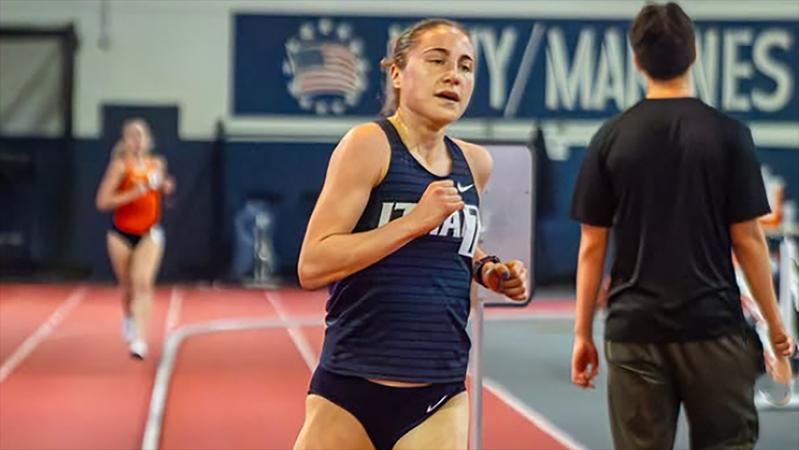
RESULTS
ITHACA, N.Y. –
The Ithaca College women’s track & field team opened its 2025-26 season over the weekend as the Bombers made the short trip across town to compete in the Greg Page Relays hosted by Cornell University on December 5-6.
Lola Gitlin posted a time of 10:25.57 in the 3000-meter run to finish third overall.
Rachel Larson was a fourth place finisher with a time of 8.58 seconds in the 60-meter hurdles. That time is currently No. 1 in Division III after the opening weekend of the season.
Aynisha McQuillar took fifth in the 200-meter dash in a time of 26.61 seconds. McQuillar also ran in the 60-meter dash and posted the 11th fastest time in DIII during the prelim with a performance of 7.78 seconds.
Lyla Powers was fifth in the 500-meter dash with a time of 1:21.75.
Lily Seyfert claimed fifth in the shot put with a heave of 12.78 meters, which is currently ninth in the nation.
Bree Boyle and Erin Eastwood each cleared 3.54 meters in the pole vault, which is tied for 11th on the Division III performance list.
Alexis Brown turned in a leap of 11.02 meters in the triple jump for the 17th best mark in the country.
Ithaca is off for the remainder of 2025 and will return to Cornell on January 10 for the Southern Tier Invitational.
Sports
Men’s Track & Field Opens Indoor Season at Cornell Greg Page Relays
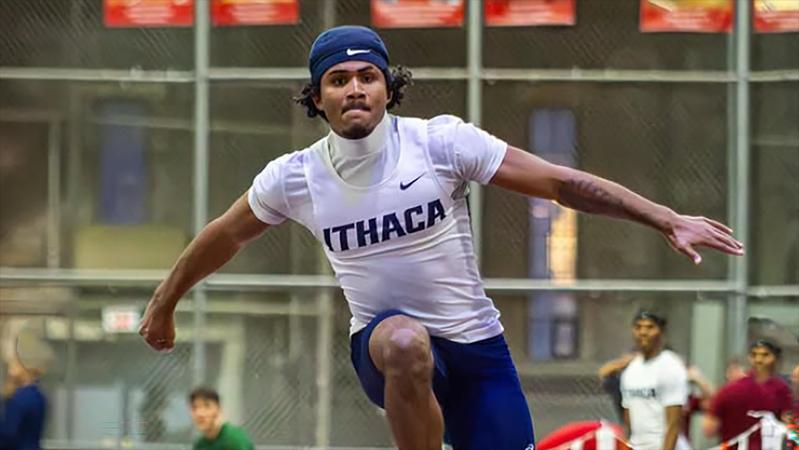
RESULTS
ITHACA, N.Y. –
The Ithaca College men’s track & field team opened its 2025-26 season over the weekend as the Bombers made the short trip across town to compete in the Greg Page Relays hosted by Cornell University on December 5-6.
Anik Vossschulte claimed third in the 200-meter dash in a time of 23.32 seconds, while Jacob Antilety was seventh at 23.71 seconds.
Matt Lokshin posted a time of 8.65 seconds in the 60-meter hurdles to place third in the event. Aidan Irwin took fourth in the high jump with a mark of 1.70 meters.
Quinten Lewis posted a mark of 13.73 meters in the triple jump to place fourth and Sebastien-Oliver Lacrete was sixth at 12.68 meters, while Evan Cherry secured fifth in the long jump with a leap of 6.84 meters.
IC’s 4×400-meter relay team of Damian Simmonds, Griffin Lupes, Noah McKibben and George Nilson placed sixth in 3:34.49.
Luke Ellor finished sixth in the shot put with a mark of 14.40 meters.
Three Bombers finished within the top eight in the 500-meter dash as Brad Kellogg was sixth in 1:09.73, Peter Tysiak followed in seventh with 1:10.74 and Matthew DeJulio was next at 1:11.59.
Kaiden Chandler and Luke Ferrer posted times of 4:41.29 and 4:53.44 in the mile to finish in seventh and eighth.
Raf Campanile was seventh in the pole vault with a clearance of 4.25 meters.
Ithaca is off for the remainder of 2025 and will return to Cornell on January 10 for the Southern Tier Invitational.
Sports
Women’s track and field athletes win three events at Utica Holiday Classic
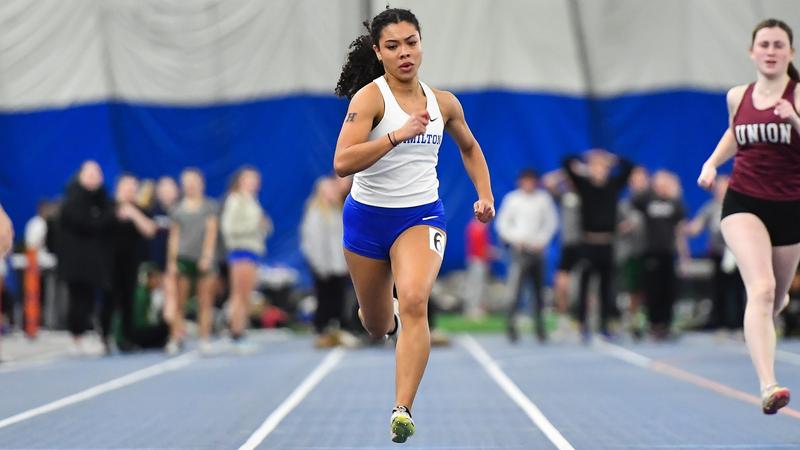
UTICA, N.Y. – The Hamilton College Continentals competed against 13 teams at the non-team scoring 2025 Utica University Track & Field Holiday Classic inside the Todd & Jenn Hutton Sports and Recreation Center on Saturday, Dec. 6.
The meet was the first of the 2025-26 season for the Hamilton women, who will be back at Utica for the Pioneers’ Winter Opener on Friday, Jan. 16 after taking a break for finals and the winter holiday.
The Continentals qualified for the 2026 All-Atlantic Region Track & Field Conference Indoor Championships in four different events and finished first in three events.
Emily Pogozelski ’26 won the 3,000-meter run by over 20 seconds with a regional-qualifying time of 10:27.93. Mackenzie Loudon ’29, who was competing in her first collegiate meet, took first place and qualified for regionals in the triple jump.
Loudon was also part of Hamilton’s winning 4×200-meter relay with Tatiana McCray ’28, Ava Chiappinelli ’29 and Marley Meyers ’28. Their performance was more than five seconds faster than the regional-qualifying time.
McCray ran a regional-qualifying 7.96 seconds and finished in second place in the 60-meter dash final. Chiappinelli also qualified for regionals in her first collegiate meet and finished right behind McCray with a time of 7.99 seconds.
TOP PERFORMANCES
300-Meter Dash (17 Runners)
4. Marley Meyers ’28, 43.08
7. Hannah Turner ’26, 43.91
60-Meter Dash (35 Runners)
2. Tatiana McCray ’28, 7.96 (PR, AARTFC)
3. Ava Chiappinelli ’29, 7.99 (AARTFC)
600-Meter Dash (16 Runners)
5. Aisha Kandji ’29, 1:47.31
4×200 Meter Relay (9 Teams)
1. McCray ’28, Mackenzie Loudon ’29, Chiappinelli ’29, Meyers ’28 (1:46.42, AARTFC)
3000-Meter Run (19 Runners)
1. Emily Pogozelski ’26, 10:27.93 (PR, AARTFC)
Triple Jump (15 Athletes)
1. Loudon, 11.29 meters (37 feet, 0.5 inches; AARTFC)
Sports
Volleyball Advances to Program’s First Sweet Sixteen, Sweeps Florida Saturday
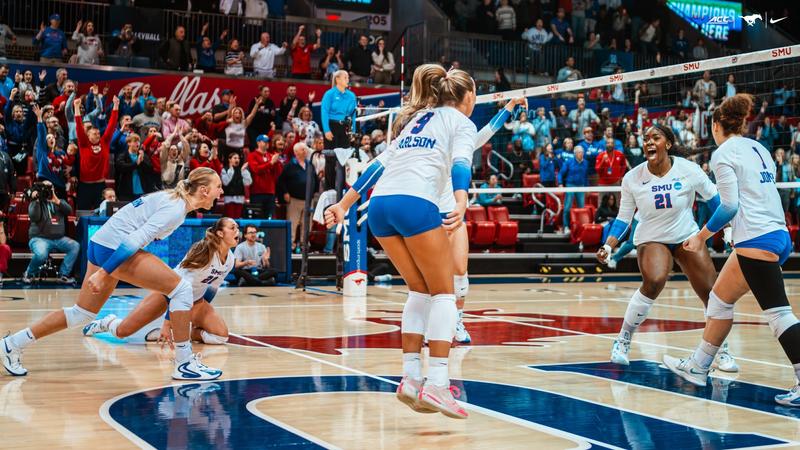
DALLAS (SMU) – For the first time in program history, SMU volleyball is headed to the Sweet Sixteen after sweeping Florida (16-12) in the Round of 32 on Saturday with set scores of 25-11, 25-21, 26-24.
With the win, SMU won its 27th match of the season, tying the program record for single-season wins. It also gave coach Sam Erger her 100th victory at SMU and in her Division I head coaching career.
Averi Carlson dished out 38 assists, the most in a three-setter for the senior setter this season. Carlson led the Mustangs to a .370 hitting percentage in the win. Kennedi Rogers went for 14 kills, hitting .440, with four digs and three blocks. Malaya Jones closely trailed Rogers with 13 kills, eight digs and seven blocks, tying her career high.
SMU out-blocked the Gators 15-4, spearheaded by a career-high nine blocks from freshman Maggie Croft. The Mustangs’ blocking efforts helped hold the Gators to a .156 hitting percentage for the match.
MATCH NOTES
- With 13 kills against Florida, Jones (503) is now the second player in SMU Volleyball history to reach 500 kills in a season. She joins Rachel Giubilato, who notched 568 kills in 2006.
- Averi Carlson (1,341) moved to third in the rally scoring era and sixth all-time for single-season assists at SMU.
- Jones reached the double-digit kill mark for the 26th time this season and for the ninth straight match.
- Rogers recorded double-digit kills for the sixth time this season.
- It marked Schilling’s 22nd time in double-figures this season and her fifth straight.
- With six blocks against the Gators, Anyanwu draws within 14 of breaking the program record for most blocks in a season. (188 by Janelle Giordano in 2015)
- SMU had double-digit blocks (15) for the 17th time this season and for the second straight match.
- SMU has won 20 of its last 21 matches and its 12th straight.
- The Mustangs end the 2025 season with 15 wins at Moody Coliseum, tying the program record for most in a season.
- The win marks the Mustangs’ 15th sweep, 11th at home this season.
HOW IT HAPPENED:
SMU controlled the first set from start to finish in all phases of the game. SMU hit .483 with no errors on 29 swings in the first, while holding Florida to a .000 hitting percentage. Rogers put in five kills to lead the Mustangs, who got point production from six different players to help propel them to a 25-11 set one victory. SMU commanded the net with a 5-0 advantage in blocks.
Down four (16-12) in the second frame, SMU responded with five straight points on a run that included two aces from Madison Scheer. After trading points, SMU went on a 4-0 run to pull away in the frame. The Mustangs went on to win the frame 25-21.
Tied 20-20 entering the red zone of the third set, SMU got the first two points on an ace from Carlson and a block from the freshman tandem of Rogers and Croft. Despite a 3-1 run by Florida that put the Gators at set point first, the Mustangs responded with three straight to close the match, ending the frame with their sixth block of the set to win 26-24.
SMU LEADERS:
SMU Kills Leader: Kennedi Rogers (14)
SMU Assists Leader: Averi Carlson (38)
SMU Digs Leader: Jordyn Schilling (11)
SMU Blocks Leader: Maggie Croft (9)
SMU Ace Leader: Madison Scheer (2)
SMU Points Leader: Malaya Jones (17.5)
Up Next: SMU will get a rematch with No. 3 seed Purdue in the NCAA Regional Semifinal on Thursday evening in Pittsburgh, Pa.
Sports
Trans volleyball player Blaire Fleming hits back at claim about female teammate’s eating disorder
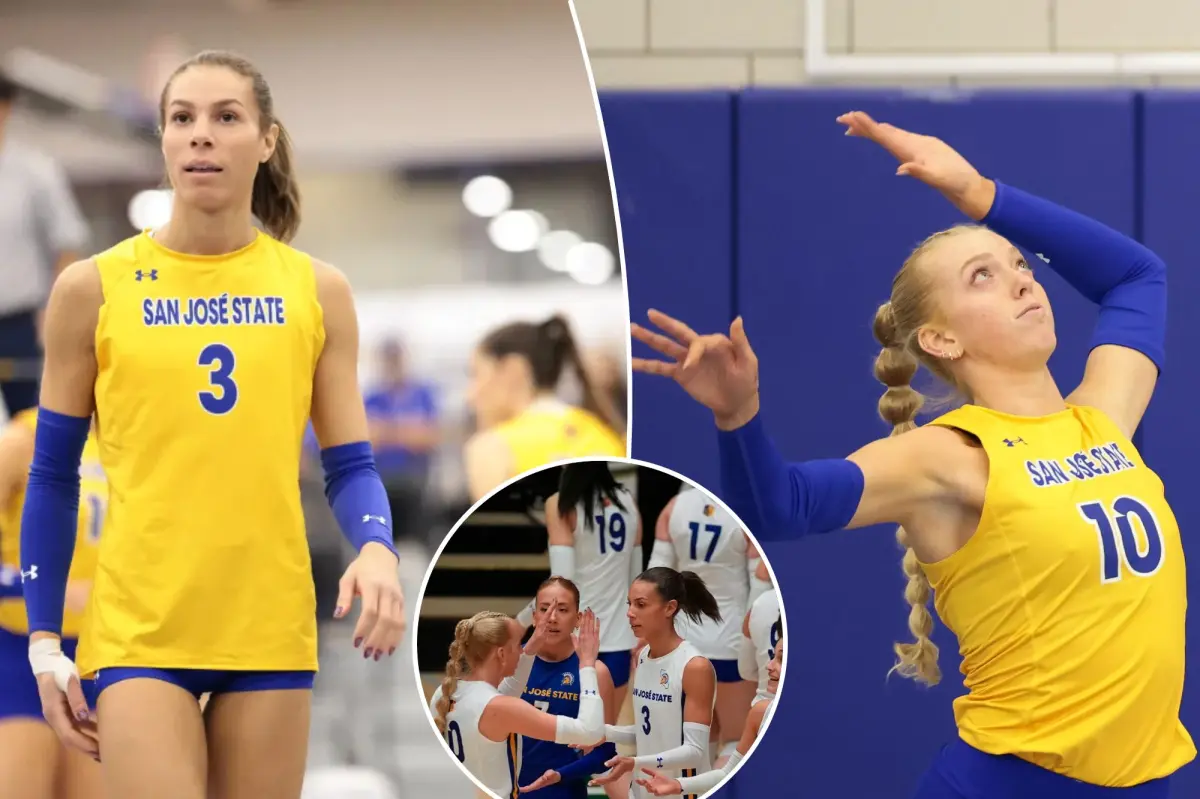
Transgender college volleyball player Blaire Fleming has hit back at claims that she triggered her teammate’s eating disorder due to emotional distress — and said that she doesn’t “feel bad for her.”
Fleming, 23, was at the center of a scandal last year involving Brooke Slusser, who filed multiple lawsuits against her San Jose State University (SJSU) teammate after discovering that she was transgender.
Slusser alleged that the panic and stress from that period of her life led her to develop an eating disorder, leading to anorexia so severe that her menstrual cycle stopped for nine months.
The pair had previously shared hotel rooms and changing spaces for a whole season in 2023 before Slusser said she found out that Fleming, who is biologically male but reportedly started medically transitioning at 14, was trans.
“From the stress and how anxious I was every single day, I just wasn’t eating really at all,” Slusser told Fox News Digital last week.
“I went from around 160 to 128 [lbs] in that one semester. It definitely isn’t healthy for someone of my size to be that weight, and I ended up losing my menstrual cycle for nine months. So it was definitely severe,” she said.
Slusser later dropped her classes in the final semester this past spring, citing constant in-person harassment by students who opposed her stance.
Fleming has since responded, claiming that Slusser’s eating disorder dated back for as long as she knew her, prior to her learning that she was trans.
“She’s been anorexic and struggled with food since I’ve known her aka since 2023. She literally would weigh herself 2-3x a day and keep track of it on her whiteboard in her room,” Fleming told Fox News Digital on Sunday.
“So I really don’t care or feel bad for her. And she didn’t drop her classes, she failed out, hope that helps!” Fleming said.
Slusser has now come back and disputed Fleming’s allegations.
“These statements are just not true. I have always lived a very healthy lifestyle. Before these events took place I was very disciplined in fueling myself for athletics and [kept] track to make sure I was where I need to be to be the best athlete,” Slusser told Fox News Digital.
“It wasn’t until all the craziness started that my healthy lifestyle turned very unhealthy into not eating the amount I should,” Slusser said.
“As for school, I decided to stay home after fall 2024 to better myself and heal. So no, I did not return to San Jose and enroll myself in more courses at an institution that didn’t have my best interest,” she added.
Slusser alleged that she was never told Fleming’s birth sex and said the two regularly shared hotel rooms on away trips, according to her lawsuits filed against the NCAA and Mountain West Conference.
Fleming allegedly requested to be roomed with Slusser, a request she said was granted by team leadership, according to lawsuits.
Slusser said that the 6ft1 Fleming confessed to being transgender during a conversation over ice cream with another teammate in April 2024.
In September 2024, Slusser joined swimmer Riley Gaines’ lawsuit against the NCAA.
At the same time, SJSU’s volleyball team saw a series of forfeits by opposing teams, with police protection regularly assigned.
The US Department of Education is currently investigating SJSU for potential Title IX violations.
Sports
K-State’s Season Ends in Second Round of NCAA Tournament
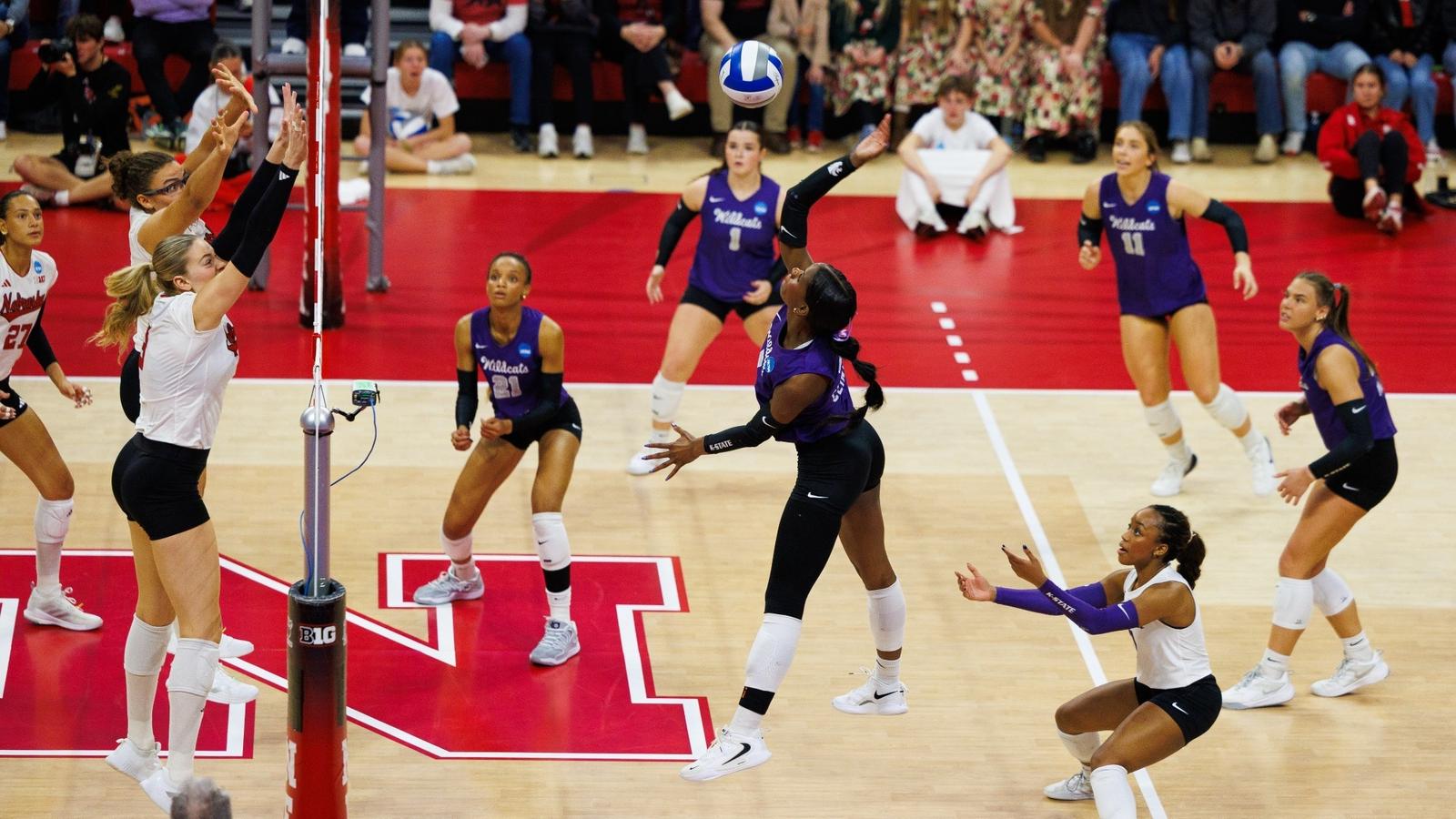
Nebraska (32-0, 20-0 Big Ten), the No. 1 overall national seed, carded 43 kills with Andi Jackson and Harper Murray each putting down 10 kills. Jackson hit at a .533 clip with two errors on 15 attempts. Taylor Landfair added eight kills.
Six different Wildcats (18-10, 10-8 Big 12) contributed a kill in the match paced by seven from Aniya Clinton. An All-Big 12 Second Team selection, Clinton turned in five digs with three blocks to lead the Cats with nine total points.
The Wildcats forced 18 errors from the Cornhuskers – Nebraska’s most since September 16 against Creighton (26) – producing an 8.0-5.0 advantage in total team blocks, led by five from senior Brenna Schmidt.
The 18 attack errors marked the Huskers’ fourth-highest total of the season, joining 20-plus error outings against Creighton (26), Kentucky (25) and Pittsburgh (23).The match also marked just the fifth time in which the Cornhuskers were held below the .300 threshold, as the team’s .253 hitting percentage was the team’s fourth lowest output of the year.
Of the 52 sets played at the Devaney Center, K-State’s 21 points in Set 2 marked just the 11th set Nebraska allowed 20-plus points at home.
LeGrand, who earned All-Big 12 Second Team recognition Tuesday, handed out 19 assists to go along with a team-high nine digs. K-State also got six digs from Symone Sims and Shaylee Myers, who put down six kills.
Nebraska will advance to the Regional Semifinals of the 2025 NCAA Tournament and will face No. 16 national seed Kansas (24-10, 13-5 Big 12) on Friday, December 12 in Lincoln.
FROM THE CATS
JASON MANSFIELD, K-STATE HEAD COACH
Overall Statement…
“Congratulations to Nebraska on a really good match. Elite defensive team and their offense was good at times. I’m really proud of our team and just the fight that we had in all three sets. I felt like we battled with them for a while, just couldn’t sustain it. Just really proud of this team and what we accomplished this season.”
On the 2025 senior class…
“They’ve been special. We’ve talked about it all the way back in January, I felt like this team was going to take the program to a different place and the seniors were going to lead us in that direction, and they have. All five of them are very unique, very special, they’re different in their own way. They’ve added so much to our program their whole career, really, but their senior season was special. There’s no substitute for urgency and I think they were really urgent this whole season in trying to get us to this place. I’m really proud of them and they’ll be remembered forever.”
AVA LEGRAND, SENIOR SETTER
On setting the standard for the next generation of K-State players…
“We want it to be the standard to make it to the tournament and not only make it to the tournament, but to make it to the next round. And hopefully every year we get past the next hump. That is something we tried instilling in the freshmen and younger girls, and hopefully for the future of this program we will have a standard here and K-State is going to be one to remember.”
On ending her career in her hometown state…
“It comes full circle. I had such a great cheering section with so many friends and family members that it was so awesome to see them all out there. But also, just Bob Devaney is a special place. Growing up in Nebraska, it’s a volleyball state, can’t deny that, but hearing the fans cheer for all us Nebraska girls was pretty awesome, but I think full circle comes to mind.”
ANIYA CLINTON, SENIOR OUTSIDE HITTER/OPPOSITE
On the senior leadership…
“This is kind of where we want our program to be and we don’t want it to start here. This is a spot that we’ve brought our program, and we don’t want it to stop here. This is a spot that we’ve brought our program, and I think we’ve done a really good job as seniors leading so I hope that the next group of seniors continues to follow in our footsteps.”
SET-BY-SET
Set 1 – #1/(1) Nebraska 25, K-State 17
- Nebraska jumped out to a quick 7-2 lead behind a pair of kills from Rebekah Allick and aces from Laney Choboy and Virginia Adriano.
- Four unanswered points for K-State highlighted a 6-1 scoring run that trimmed a seven-point deficit, 15-8, to two. The run included a block by Clinton and Schmidt, along with a service ace from Emerson Van Lannen – her 28th of the season.
- The Wildcats were held to a .086 hitting percentage (8 kills, 5 errors, 35 swings) in the opening frame against the Cornhuskers’ .250 (16 kills, 7 errors, 36 attempts).
- K-State out-blocked Nebraska in Set 1, 4.0-2.0.
Set 2 – #1/(1) Nebraska 25, K-State 21
- The Wildcats captured their first lead of the match, 4-1, with a pair of blocks from Schmidt, Clinton and LeGrand.
- After seven tied scores, Nebraska ran away with a 4-0 scoring run to take the first substantial lead of the set, 13-10, but was answered with kills from Schmidt and Reagan Fox to make it a one-point score.
- K-State came out of a timeout with a kill from LeGrand to spark a 4-1 run, that included three consecutive kills from LeGrand, Fox and Clinton, bridging the gap to two, 22-20.
- The run forced a timeout from Nebraska, their first of the match, and was followed by a solo stop by Schmidt.
- With the score notched at 22-21, Nebraska put together a 3-0 closing run to put the set away.
- K-State recorded a set-best .171 hitting percentage behind 12 kills on 35 attempts with six errors, while the defense limited Nebraska to a .139 clip (12 kills, 7 errors, 36 swings) with four blocks.
Set 3 – #1/(1) Nebraska 25, K-State 16
- After back-and forth action, the Wildcats pieced together a 4-0 scoring run to take a one-point lead.
- Tied 8-8, the Cornhuskers rattled off an 8-1 scoring run to overcome the deficit and take control of the set.
- K-State managed just seven kills in the final set, hitting at a .097 efficiency, while Nebraska turned in a match-high .393 clip (15 kills, 4 errors, 28 errors).
INSIDE THE BOX
- Nebraska defeated K-State in straight sets to advance to the Regional Semifinals – 25-17, 25-21, 25-16.
- K-State turned in a .118 hitting percentage (27 kills, 15 errors, 118 attempts), while Nebraska finished with a .243 efficiency (43 kills, 18 errors, 99 attempts).
- The 18 attack errors marked the Huskers’ fourth-highest total of the season.
- The match also marked just the fifth time the Cornhuskers were held below a .300 hitting percentage.
- The team’s .253 hitting percentage was the team’s fourth lowest output of the year.
- Clinton led the Wildcats with seven kills to go with five digs and three blocks.
- Myers finished with six kills while Fox added five.
- LeGrand handed out 19 assists and logged a team-leading nine digs.
- LeGrand and Van Lannen each recorded a service ace.
- The Cats out-blocked the Cornhuskers, 8-5.
- Nebraska was led by Jackson’s 10 kills at a .533 clip. Murray also put down 10 kills.
- Olivia Mauch finished with a match-high 13 digs and Laney Choboy picked up 12.
- Of 52 sets played at the Devaney Center, K-State’s 21 points in Set 2 marked just the 11th set Nebraska allowed 20-plus points at home.
BEYOND THE BOX
- In its history, K-State has made the NCAA Tournament 19 times, advancing to the Regional Semifinal three times (2000, 2003, 2011).
- K-State is 16-19 overall in the tournament, that includes a 3-10 record in the second round.
- The Wildcats advanced to the second round of the NCAA Tournament for the first time since 2016, making the program’s 12th overall appearance in the round.
- The 2025 postseason run marks K-State’s sixth time being sent to Lincoln for the first-round in school history (2011, 2012, 2014, 2015, 2021, 2025).
- Nebraska leads the all-time series 84-4, that includes a 36-3 record at home.
- Saturday’s contest marks the third meeting between the Wildcats and Cornhuskers in the postseason and first since 2011.
- The Cats are 1-2 in the postseason series vs. the Huskers.
- In 2011, K-State upset third-seeded Nebraska in five sets to advance to the team’s third NCAA Regional Semifinal (Sweet 16).
- The Wildcats were 9-5 in three-set matches this season.
- K-State is now 9-9 is three-set matches all-time in the NCAA Tournament.
-

 Rec Sports2 weeks ago
Rec Sports2 weeks agoFirst Tee Winter Registration is open
-

 Rec Sports2 weeks ago
Rec Sports2 weeks agoFargo girl, 13, dies after collapsing during school basketball game – Grand Forks Herald
-

 Motorsports2 weeks ago
Motorsports2 weeks agoCPG Brands Like Allegra Are Betting on F1 for the First Time
-
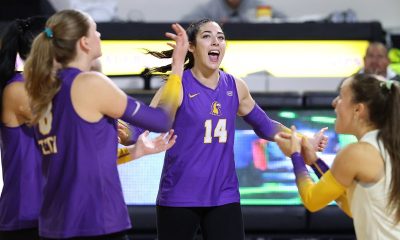
 Sports3 weeks ago
Sports3 weeks agoVolleyball Recaps – November 18
-

 Motorsports2 weeks ago
Motorsports2 weeks agoF1 Las Vegas: Verstappen win, Norris and Piastri DQ tighten 2025 title fight
-

 Sports2 weeks ago
Sports2 weeks agoTwo Pro Volleyball Leagues Serve Up Plans for Minnesota Teams
-

 Sports2 weeks ago
Sports2 weeks agoUtah State Announces 2025-26 Indoor Track & Field Schedule
-

 Sports2 weeks ago
Sports2 weeks agoSycamores unveil 2026 track and field schedule
-

 Motorsports1 week ago
Motorsports1 week agoRedemption Means First Pro Stock World Championship for Dallas Glenn
-

 NIL7 days ago
NIL7 days agoBowl Projections: ESPN predicts 12-team College Football Playoff bracket, full bowl slate after Week 14



























